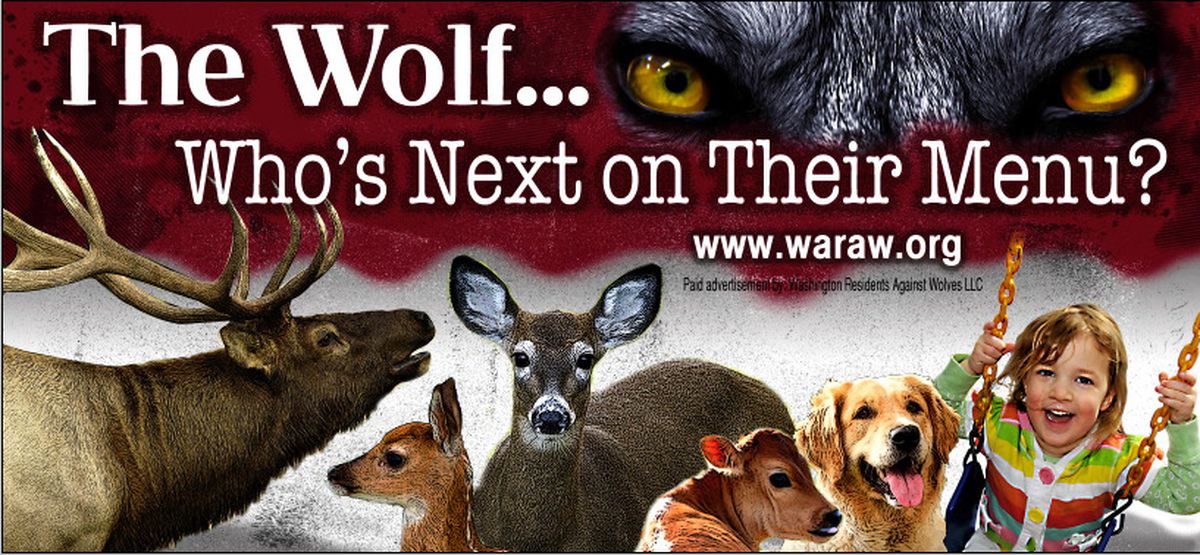Polarized wolf groups battle with billboards

Opposing views of gray wolf recovery in Washington are on display in a Spokane-area battle of the billboards.
The Defenders of Wildlife, a national wildlife advocacy group, has contracted for nine billboard posters that appeared this month. The message responds to a similar outdoor advertising campaign initiated in November by an anti-wolf group called Washington Residents Against Wolves.
Four of the eight WARAW billboards feature photos of a deer, an elk, a calf, a dog and a young girl on a swing with the text: “The Wolf – Who’s Next on Their Menu?”
“What we want is for people to ask very serious questions about the presence of wolves in Washington State before the reality confronts them,” said WARAW spokesman Luke Hedquist in a media release introducing the campaign.
In response, Defenders has put up nine billboards with the headline “Reality Check! What’s More Dangerous?” Four images help answer the question based on average deaths per year in the United States: “Lightning 33. ATVs 413. Elevators 26. Wolves 0.”
“We just want to cut through the myths to the facts,” said Shawn Cantrell, Defenders Northwest director based in Seattle.
Gray wolves remain under state endangered species protections in Washington as they naturally reoccupy their native range in the state.
Several confirmed wolf attacks have resulted in dozens of dead cattle and sheep in the past few years in Ferry, Stevens and Whitman counties.
Close encounters with wolves have occurred in Washington but no attacks on people have been reported.
Since 1888, one wolf-caused fatality has been confirmed by state wildlife officials in the United States. That was in Alaska in 2010.
Defenders is paying about $4,000 a month to have its message displayed on nine billboards, Cantrell said.
Defenders has helped with designing the posters and getting them on display, “but the bulk of the funding was initiated by local folks who thought the WARAW posters were outlandish and needed a response,” he said.
“They approached us and set up a GoFundMe site to raise money online. It didn’t take them long to get enough contributions to pay for the billboards.”
Jamie Henneman, publicist for WARAW, declined to name the funding source for its billboard campaign. She also is a media contact for the Stevens County Cattlemen’s Association,
David Burdge, a WARAW spokesman and member, told the Capitol Press, a Western agricultural weekly, that the group has 20 members. He said the group is concerned about the health and safety of Washington wildlife and residents and is not affiliated with any other organization.
Hedquist and Burdge have both been elected to the Inland Northwest Wildlife Council board of trustees.
“We do not despise the wolf for being a wolf,” Hedquist said. “Wolves are efficient killers and can provide a necessary control on ungulate herds in some situations, but the job of ‘predator’ in Washington is already filled by cougars, bears and coyotes. By adding a wolf to the mix, we are forcing predators to compete for a limited prey base and we know they will move on to domestic animals and possibly children as new sources of food.”
The first four billboards put up by WARAW featured a snarling wolf with teeth bared and the caption: “Endangered? No. Deadly? Yes. Good for Washington? Absolutely not!”
The group’s second wave of posters insinuated that wolves were likely to kill kids. That prompted Defenders to react, Cantrell said.
“Our basic message has always been let’s understand the facts,” he said. “The lies and myths about wolves need to be countered.”
The Spokane campaign is the first time Defenders has used billboard advertising in Washington, he said.
But the wolf issue is prompting the national group to assume a larger profile in the state. Cantrell, a Northwest native, was hired in August to open Defenders’ first office in Washington.
“We are working on the wolf issue in a variety of ways,” he said, noting that a basic theme confronts the fear-based approach of many anti-wolf groups.
“We’ll be doing public education and outreach to livestock operators in Eastern Washington, although not in Stevens County where things are at a fever pitch.”
Several wildlife groups, including West Side-based Conservation Northwest, already have been working on wolf issues in Washington.
“Defenders is collaborating with all of them,” Cantrell said. “We’ll be trying to get ahead of the curve where we can approach the return of wolves as a positive and help people understand how we can coexist.”
Cantrell said he’s beginning to focus more effort in Western Washington, where there are no wolves, but a majority of voters.
“The Legislature, the Governor, the wildlife officials – they’re all paying attention to what the public thinks about wolves,” he said.
Asked for a comment on the Spokane battle of the billboards, Washington Department of Fish and Wildlife spokeswoman Madonna Luers said, “Our positions are based on the best science available and laid out in the state’s Wolf Conservation and Management Plan.”
Burge told the Capital Press, “We are not for eradicating the entire population. We would like to have the department look at their wolf management plan and cut the numbers down to something much more realistic.”
Jack Field, executive vice president of the Washington Cattlemen’s Association, said the group is not affiliated with WARAW, but he finds no problem with the group’s billboard campaign.
“It shows there’s a broad crosscut of folks that have opinions on it,” Field told the Capital Press. “I think these billboards help to explain some of the concerns folks have. In the northeast corner of Washington, the overall pack density looks disproportionate compared to the rest of the state. This just helps elevate the discussion.”